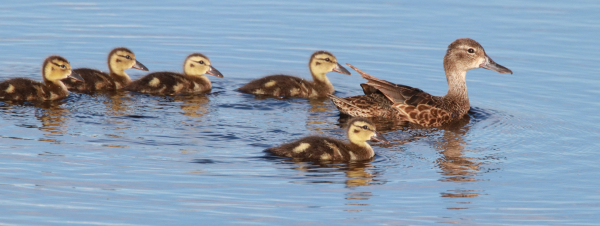
Even when you have the perfect setting for a new duck family to swim through, with calm water reflecting bright blue sky, how do you get 5 downy ducklings led by an adult Blue-winged Teal to provide such a pleasing testament to the beginning of the summer duckling hatch. Trying not to worry the week-old ducklings or the female, I waited for them to move from one feeding area to the next, hoping they would swim through a more open space – and they did! I took several photographs, but this image was the one that had the best lighting, colors, and spacing among the ducks. However, it had one flaw: I misjudged the end of the last duckling by a couple inches, so it’s not perfect, but what is? I used a relatively broad f-10 aperture with the hope of having all the ducks in focus, and the shutter speed was fast enough to stop all the action and a provide sharp image. I’ve taken a lot of photographs of duck broods, but this is a standout, in spite of the little flaw – or maybe because of it. Perhaps it will become a conversation piece (600mm zoom lens, f-10 aperture, 1/1000 shutter speed, 800 ISO).
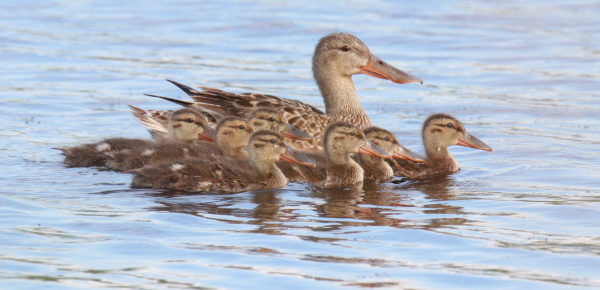
I used the same technique to photograph this adult female Northern Shoveler and her brood of 10-day-old ducklings – photographing on a mostly sunny afternoon with the lowered sun behind me to illuminate the ducks and the water. The fluffy white clouds that broke up the blue sky Saturday afternoon provided an interesting pattern reflected on the water. Each female with a brood tends to act as an individual, and while this shoveler didn’t overreact to my presence, she calmly gave a low call that brought the ducklings into a close huddle – seemingly not out of fear, but out of caution. And after taking 3 photos I left them to resume their foraging period in the open water. In this case the light was not as pronounced, so while I wanted a wide aperture to keep all the ducklings in focus, I had to compromise by using an f-9 aperture, but that brought the shutter speed lower than I would usually consider acceptable when using a zoom lens with high magnification – just 1/320 of a second. But by stabilizing the lens against my car’s window frame and holding my breath, the resulting photos were perfectly sharp and all the ducklings are in focus, along with the elegant female (500mm zoom lens, f-9 aperture, 1/320 shutter speed, 800 ISO).
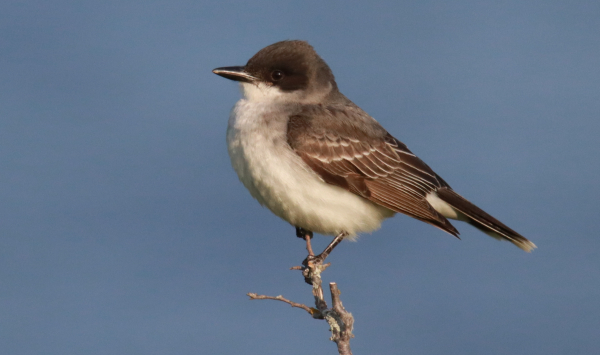
Although this is a rather mundane portrait of Eastern Kingbird, the evening sunlight was perfect as it highlighted the gray, white, and black plumage of the flycatcher, and how could I resist a photo of any bird with that deep blue lake water as a backdrop. Even so, I wanted to ensure the background was a uniform color, so I blurred it out of focus by using an f-6 aperture. When viewing the kingbird’s plumage and even individual feathers on the big screen of my computer, it’s quite impressive to see the levels of subtle detail and color variation revealed in this photograph, along with the sunlight reflecting on the kingbird’s beak and eye (600mm zoom lens, f-6 aperture, 1/2500 shutter speed, 800 ISO).
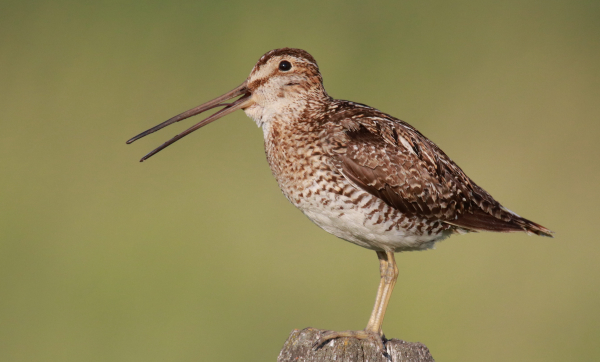
Not far down that same very rural road, a Wilson’s Snipe provided an opportunity to take a similar portrait with the added element of some action as the snipe called on territory. The birds were particularly active in the early evening sunlight, and it seemed many were advertising their territory or still hoping to attract a mate. The background colors of marsh sedges were blurred out of focus by using the narrow f-6 aperture, and the resulting color compliments the snipe’s plumage in a pleasing way. Snipe also perform a dramatic flight display accompanied by more of a ‘winnowing’ sound, but this bird maintained its stationary perch (600mm zoom lens, f-6 aperture, 1/2500 shutter speed, 800 ISO).

Expanding the idea of a species portrait beyond a close-up, I composed a more environment-laden view of a territorial Bobolink singing in a meadow filled with a variety of grasses and flowering plants. It was a toss-up as to whether I should try to emphasize the bird in this landscape by blurring the surrounding plants out of focus with a narrow f-6 aperture, or retaining a more natural view of the surrounding meadow vegetation, perhaps overpowering the smallish Bobolink in song. Actually, I was positioned so far away that this was the only image that showed the bird in focus during its rather physical singing bout in which it even spread its wings to its sides and fanned its tail at times. The Bobolink also performed flight displays complete with songs, but the photos I took of those arial forays were slightly out of focus too. But I wanted to share this image as something different, even if it is a bit of a compromise from the photos I envisioned while taking them in the field (600mm zoom lens, f-6 aperture, 1/2500 shutter speed, 800 ISO).
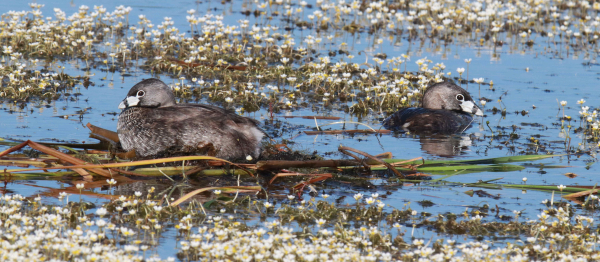
A tranquil view of a pair of nesting Pied-billed Grebes, one incubating with the other resting close by in the midst of a small shallow marsh partly covered with small flowering emergent plants. The setting of this new nest in the open, surrounded by the aquatic carpet of tiny blooms, made a unique setting for a quick photograph with the hope of not disturbing the ambiance of the moment. The grebes built the nest close to a relatively busy country road, but I needed to zoom out to include more of the surroundings and both grebes. I also dialed in a very wide f-13 aperture setting to ensure both birds were in focus and that more flowered landscape was clear too. Now I await the possibility of photographing downy grebe hatchlings in a few weeks (400mm zoom lens, f-13 aperture, 1/400 shutter speed, 800 ISO).
Good Luck as you devote a little more holiday time to your bird photography interests. It’s certainly prime time to photograph a variety of birds in most areas of North America, and perhaps you’ve even planned some extra vacation time to travel beyond your neighborhood. Enjoy these early days of July!
Article and Photographs by Paul Konrad
Share your bird photos and birding experiences at editorstbw2@gmail.com